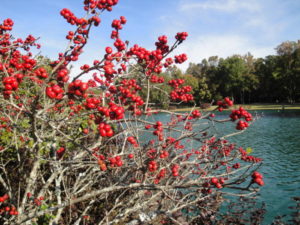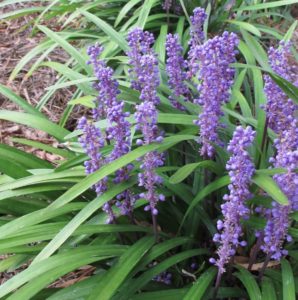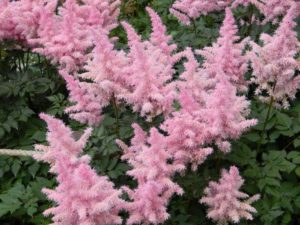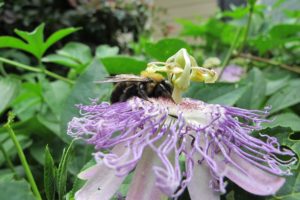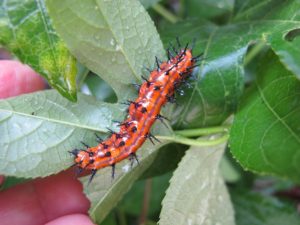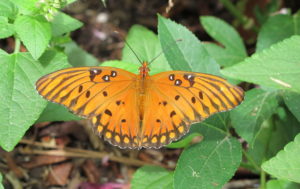Page 2
The Lawn
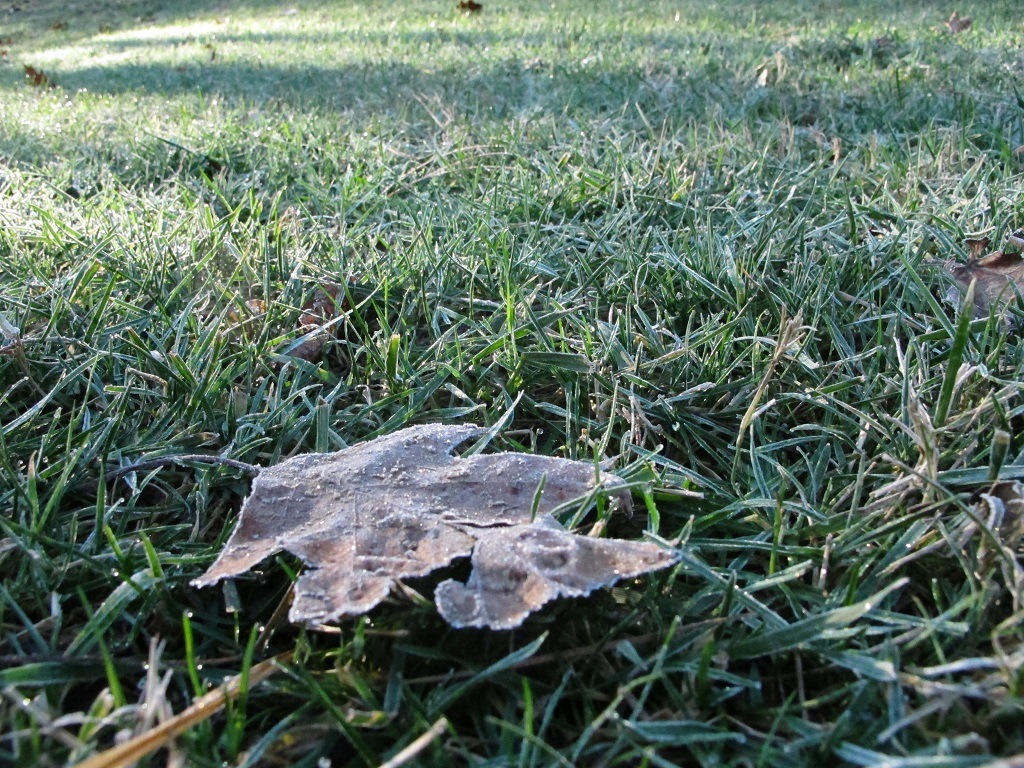
The lawn in Charlotte, with frost.
Safety First
Before mowing for the first time, walk around and inspect the entire property. Look for holes and debris concealed under a few inches of growth.
Collect hazardous materials, such as twigs, litter, and rocks that can turn into sharp projectiles. Wire, rope, and inconspicuous deer netting will jam a spinning blade in a fraction of a second. They’re not only serious safety hazards, but they also necessitate more frequent blade sharpening or expensive repairs. Keep pets and family members away from areas being mowed.
Research your town’s policy concerning leaf removal at the curbside. Some towns pick up piles of loose leaves or require you to stuff them into paper bags. Never drive over leaves piled at the curbside; there might be children playing there. And don’t park over leaves, which could ignite from a hot engine.
Less Grass to Mow
A new self-propelled mulching mower and I spent around 6 hours over 2 days cutting the grass. The self-propelled feature makes this work much easier. I haven’t cut grass myself in many years. My son, Logan, took on that chore when we lived in Maryland, and the HOA in Charlotte.
I’ll spend less time mowing as low maintenance new gardens become established where grass and weeds now grow. Not using a riding mower is a “self-propelled imperative” to get rid of the grass.
A removable chute on the mower’s deck directs grass clippings and leaves off to the side. At this time, I’m cutting mostly fallen leaves, which are moved to the woods or into piles. Don’t aim clippings toward people, the house, or vehicles.
Cutting wet grass and succulent growth causes them to clump inside the deck and on top of the lawn. Always wait for the dew or moisture to dry before mowing. Cut across a slope, generally, not up and down. It’s all in the manual.
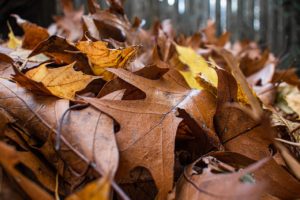
Oak leaves, mostly.
Those leaf piles will begin to decompose over the next several months, forming a compost base for pollinator gardens or shrub borders. As I become more familiar with the property, I’m envisioning the landscape potential for each area.
Removing the chute on the mower chops grass and leaves into smaller pieces. A barrier remains in place to deposit clippings (the “mulch” in mulching mower) under the blade. With more surface area exposed to air, water, and microbes, chopped leaves decompose faster than whole leaves. This debris adds organic matter to the soil and provides nutrients to the plants as it breaks down. Free mulch and fertilizer, courtesy of Mother Nature.
Grass Clippings
If desired, use the bag attachment to collect debris. You could dump a limited amount of clippings into the compost pile, under the trees and shrubs, or over the perennial bed. Many towns collect it. Use clean clippings, from chemical-free zones, around fruit trees and vegetable gardens.
It’s a myth that thatch builds up when letting clippings lie on the lawn. Use recommended varieties of grass for your climate, cut often, and don’t overfertilize. Avoid scalping the lawn and raise the deck to about 3-3½” for turf-type tall fescues. Collecting this material is not necessary if you’re cutting the grass often, removing only 1/3 of the blade.
I’ve never bagged grass clippings. The small pieces filter down into the lawn and break down rapidly, feeding the grass, earthworms, and microbes living in the soil. In fact, they supply about 1/3 of the lawn’s nitrogen needs.
Spontaneous Combustion
Don’t gather fresh grass clippings into large piles. They can generate considerable heat when decomposition begins. Instead, mix them with brown leaves and small twigs, and distribute them in a thin layer over the gardens. Clippings can be composted, but mix other materials with them and use smaller quantities.
Injecting air suddenly into a pile of hot grass clippings can cause spontaneous combustion. Be careful. You could cool down a steaming pile with lots of water, and then spread it out. This rare phenomenon requires a particular set of conditions (air, water, size of pile), but it does happen. Never store grass clippings, compost, or a hot mower near flammable materials, such as gasoline, chemicals, wood, or paper.
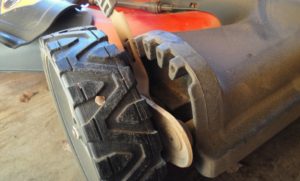
Drainage
Clear all debris from swales, drains, and ditches so water can flow freely. When grading the surface, 1″ of slope over 4′ ordinarily is sufficient.
Clean the gutters and adjust downspouts so water moves away from the foundation. Position splashpans so water flows out the open end of the pan. In the future, I’ll bury 4″ drainpipe from the downspouts to the proposed gardens down the gentle slope.
If a damp basement or crawl space is an issue, a little sleuthing might reveal the water source. By all means, prevent water from collecting outside against the foundation. It should always flow down the slope and away from the house. Call in the professionals if your remedies haven’t worked. Some conditions, such as a high water table or persistent mold, are problems beyond most DIY capabilities. The foundation might require work, such as stabilization, sealing cracks, and waterproofing. While work is being done, look into adding foamboard insulation made for the purpose.
Locate and label the electrical, furnace, and gas shut-off switches and the water shut-off valve. Disconnect garden hoses from outdoor spigots before freezing temperatures come around, and drain the hoses before storing them for the winter. In cold climates, those spigots might require additional means to protect pipes from bursting. I fill large black trash bags with dry oak leaves and place them against the wall and over the spigots, even though the pipes inside the wall drain and shouldn’t freeze. Ounce of prevention…
Observe drainage patterns across your property, looking for areas where water puddles for more than a day. Fill in low spots with mostly mineral-based materials, such as mixtures of clay, loam, and sand. Organic matter, on the other hand, decreases considerably in volume as it decomposes, leaving behind a small fraction of its original volume. As a result, that depression eventually will reappear after filling it with organic matter, such as compost, aged manure, peat moss, and coir. You might prefer to wait until spring for this chore, when you could seed the area.
Hold the Water
Consider using these depressions to your advantage. Water collects in them and slowly percolates through the soil instead of draining away. They could serve as a mini reservoir for a new tree or shrub border. But don’t plant at the bottom of a deep depression; instead, plant near the edge.
Large areas that drain poorly can become rain gardens, if desired. Keep those low spots, where soil stays moist and sometimes wet. Plants that might thrive there include winterberry (Ilex verticillata, a deciduous holly), Virginia sweetspire (Itea virginica), clethra, astilbe, some ferns, and clumping liriope (photos, below). Plants naturally help dry out wet spots as they transpire water vapor to the atmosphere.
Smart land/water management practices recommend keeping all rainwater on the property. In fact, some states and counties have imposed a rain tax based on a property’s square footage covered by impermeable surfaces.
Percolation is preferable to letting water reach storm basins down the street. Runoff from residential properties and farms carries fertilizer salts that can cause “algal blooms” in lakes and bays. This contamination threatens populations of fish and shellfish and the livelihoods of those who harvest them. Soil and roots filter the runoff, removing salts before the water reaches underground aquifers.
When fertilizing your lawn and gardens, sweep the granules that landed on paved surfaces back around the plants, now that you know the damage they can do. Avoid discharging grass clippings into the street for the same reason.
Many states have suffered the consequences of antiquated water management policies and are now instituting regulations to correct the problems. Each of us can play our part in conserving this precious resource whether you live on a fifth of an acre or 50 acres.
- A small variety of winterberry.
- liriope.
- Astilbe for moist soil, part sun.
New Gardens For Old Plants
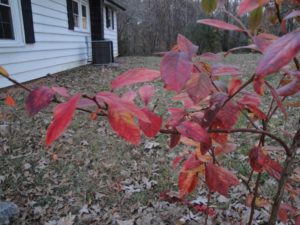
Blueberry ‘Patriot’ in fall color, planted on the east side of the house.
After I unpacked the essentials, my thoughts wandered to starting new gardens. Where would the potted dogwoods would go, the blueberry, strawberries, and raspberries? Viburnum x juddii still in its 6″ pot, 2 flats of hostas, and a large wood fern (Athyrium filix-femina ‘Lady in Red’) brought from Maryland?
Several Japanese maple seedlings (now over 6′), ‘Dorothy Wyckoff’ pieris, ‘Bridal Veil’ spirea, astilbes, and a pink crape myrtle volunteer also need homes.
The Itoh peony ‘Kopper Kettle’ had a rough summer and defoliated early. I bought this peony from a fellow vendor at the Garden Festival at Ladew, in Monkton MD, about 15 years ago. It has been living in its 3-gallon pot ever since.
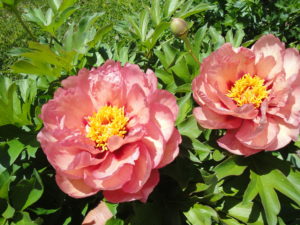
Itoh peony ‘Kopper Kettle’ in 2023, after moving to the cottage garden.
All these plants have been traveling with me for many years. The hostas have lived in their crumbling 4½” pots for a decade, but they leaf out every spring. I can almost hear them moaning, “Is this the year we’ll move to a new home…please?”
Three of the huge-growing ‘Blue Angel’ hostas got their wish. I planted them in a new bed near the back deck, on a slope too dangerous to mow. A small and rather frail variegated dogwood that has been potted for 7 years shares that space with the hostas.
I haven’t yet seen one deer, but there are few plants here that would interest them. Hosta is deer bait, so we’ll see. (***Update***: They’re here! In the fall, males rubbed their new antlers on the young Japanese maples, stripping the bark. And they found the ‘Blue Angel’ hostas, which had to be moved anyway because the sun was too strong for them on the bank. 12/2022)
Before planting the potted trees and perennials, I called 8-1-1 to mark underground utilities.
Virginia Sweetspire
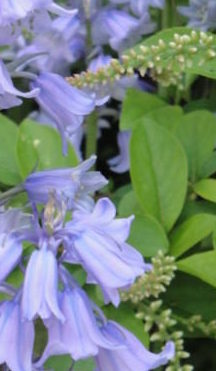 I brought from Maryland a Virginia sweetspire, Itea virginica ‘Henry’s Garnet’. It had been growing in the front garden in Charlotte, but was removed 2 years ago. It grew too exuberantly for that spot.
I brought from Maryland a Virginia sweetspire, Itea virginica ‘Henry’s Garnet’. It had been growing in the front garden in Charlotte, but was removed 2 years ago. It grew too exuberantly for that spot.
Itea rhizomes (underground stems) sometimes sprouted, so I saved a 3″ section that had grown this summer. It was unceremoniously stuck into a pot. That 10″ pot holds a clematis, columbine crowns, bulbs, and now the glowing itea. Since this plant is easily propagated, I’ll use divisions to expand the gardens.
I would have ignored the itea or perhaps weeded it out if I hadn’t recognized its rich fall color. This hardy native plant will get a prime location to grow and sucker and show off its autumn jewels. It’s a low maintenance deciduous shrub, growing 3-5′ in height and blooming pristine white flowers in mid spring as leaves begin growing. (Photo—blue wood hyacinth, Hyacinthoides hispanica, from bulbs, and itea’s leaves and flower buds.)
A good place might be near the larger Southern magnolia (M. grandiflora), since the itea can take sun or part shade. It’s rarely bothered by insects or disease, and deer ignore it. This plant spreads vigorously in good soil, although you can find smaller varieties. It’s great for naturalizing where it won’t bully its neighbors. During moderate autumn seasons, itea can retain good fall color into winter.
(***Update***: I planted the itea yesterday, near the magnolia. That area with the magnolia, itea, and crape myrtle will become a large garden of flowering shrubs, bulbs, and perennials. Hmm…more blue wood hyacinths! 12/17/21)
More New Gardens and Less Lawn
With this much land, I do not look forward to mowing grass as a second job. Fortunately, the northern almost half of the property is heavily wooded and will remain so. Near the woods is a large patch of violets, with some white and purple flowers defying the cold. The rest of the property has a mixture of weeds and grass, in addition to several mature trees and the gravel driveway.
Native trees in the woods include red maple (Acer rubrum), tulip poplar (Liriodendron tulipifera), eastern redbud (Cercis canadensis), and flowering dogwood (Cornus florida). There might be some ash (Fraxinus sp.), and there definitely is black walnut (Juglans nigra).
I noticed in the distance a couple of American beeches (Fagus grandifolia) and their marcescent (dead but clinging) tan leaves after the other trees had dropped theirs. (***Update***: Invasive privet, honeysuckle, mimosa, and bittersweet have been removed. This opened up an enchanting new sightline through the woods. 8/26/2024)
The Black Walnut
A 50′ black walnut drops fruits the size of tennis balls—on a slope, no less. Must tread carefully.
A chemical called juglone, in this tree’s cells, can kill sensitive vegetation near it. That’s one type of negative allelopathy, where one plant uses its biochemicals to suppress germination or growth of competing plants. Forest animals are unharmed by the chemical, and deposit empty husks in neat piles near the back deck. Another example of allelopathy commonly seen results in bare ground below a bird feeder filled with sunflower seeds.
The walnut tree growing at the edge of the woods will remain for now. As landscaping projects proceed, I’ll reassess whether it will stay or go, but those living farther into the woods will be left for the animals. (***Update***: A major branch of the black walnut was removed last year and donated to a woodcrafter…more sightlines into the woods. 8/2024)
The Ravine and the Woodland
Since the area near the walnut rims a steep ravine, garden tasks there will be limited to piling leaves and harvesting heavily composted topsoil and leaf mold for the transplants. During rainy periods, water flows into the ravine from surrounding properties, joining a creek not far away.
I can’t resist establishing a woodland walk near the edge of the woods behind the house. Existing weeds (privet, honeysuckle, poison ivy, pokeweed) might give way to witch hazel, rhododendron, enkianthus, corylopsis, hardy ferns, spring-flowering bulbs, and a mulch path. Shrubs and perennials that attract pollinating bees and egg-laying butterflies will replace more of the lawn and provide some screening closer to the property line.
Installing these new gardens will be accomplished over time—years, in fact. An old shed will add to the effect, after it has been fortified and painted. Maybe by then the black widow spider will have moved on. Must tread carefully.
As gardens become established, I expect to spend less time mowing and more time growing. The lawn mower and I had such fun with the fallen leaves. But spending hours with that machine pointed out the urgency with which the lawn/weeds must turn into lower maintenance gardens! I’ve made a start, but there’s so much more to do. (Yay.)
Passionflower and Phlox ‘Minnie Pearl’
- Passionflower, Passiflora incarnata, with bumble bee.
- Caterpillar of gulf fritillary butterfly.
- Female gulf fritillary butterfly.
In a sunny patch near the proposed woodland walk, I planted passionflower (Passiflora, photos above). This native plant, also called maypop, hosts gulf fritillary butterflies. Their larvae feed only on a few species of passionflower vines, including P. incarnata, P. suberosa, and P. lutea. This aggressive plant can creep wherever it wants, although the woods and the mower—and the caterpillars—will limit its spread.
A small and undemanding native white-flowering phlox called ‘Minnie Pearl’ (Phlox carolina ssp. carolina) found a home under the south side of an old lichen-encrusted flowering dogwood. ‘Minnie Pearl’, spotted in Mississippi by gardener Karen Partlow, was selected and named by Plant Delights Nursery, near Raleigh NC. It’s free to colonize the transition zone at the edge of the woods.
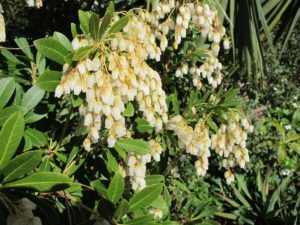
Pieris japonica.
The dogwood’s broad, outstretched arms welcome visitors to the woods, and to the seasonal sight of autumn colors beyond. Under the northern edge of its canopy, I planted the pieris. Its lightly fragrant creamy blooms will open in late winter/early spring. That’s the area where a pileated woodpecker loudly drums a dead tree, searching for insects hibernating in the wood.
Native species and nativars (cultivars of native species) will feature prominently in the gardens. They’re critical for maintaining a healthy balance among local populations of pollinators and other organisms in this ecosystem’s food chain. However, there are thousands of exotic species and varieties we gardeners often invite to our homes, and many will find their way here.
Headings
Page 1: A New Home and New Gardens! (Inspections), The Lay Of the Land, After Moving In, and Trees and Shrubs (Poor Pruning Practices, The Root Of the Problem, Constricted, Flares and Girdling Roots, English Ivy)
Page 2: The Lawn (Safety First, Less Grass To Mow, Grass Clippings, Spontaneous Combustion), Drainage (Hold the Water), New Gardens for Old Plants (Virginia Sweetspire), and More New Gardens and Less Lawn (The Black Walnut, The Ravine and the Woodland, Passionflower and Phlox ‘Minnie Pearl’)
Page 3: Planting a Few Trees (The Rule Of Thirds, Too Cold To Plant New Gardens?, Viola, Different Players—Same Script, All Those Leaves), A Welcome Surprise (A Firm Foundation, Heeling In, Iris, Chores Indoors), Christmas Already?, and Concluding
